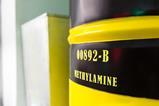How chemical intuition and guesses become the precise numbers of chemistry
When I think about precision in chemistry, I always admire our colleagues in physical and analytical chemistry. Those beautiful curves and line plots seem so perfect, so precise – in comparison with laboratory synthetic chemistry, where you’re scraping the sides of the flask to get a 97% yield. While exact values are achievable in synthetic chemistry, it feels like we often live in a grey area where there is room for 2% error, or sometimes much more.
Although precision is valuable in a synthesis, planning how to produce industrial quantities of a product might begin with something closer to educated guesswork. I’m thinking of the discussions that feel like they can be had on the back of a napkin or very quickly on a whiteboard.
Imagine you’re invited into a conference room and asked: ‘If the customer were to order 200kg of product, how long would it take to make it?’ Here’s where the estimating begins.
After some discussion with your colleagues, you decide that you have a 200 litre reactor to work with. If you’re running your reaction on a 50ml scale, that’s multiplying your reaction up by 4000 times. That’s a lot to think about, but the mental math is not that hard. 10 grams of reactant would turn into 40kg, 15g of reagent would be 60kg.
Granted, you’re probably not going to fill the reactor to the brim, and you often need to wash your solvent layer with water. That probably means that you need to scale down a little bit. But now you know that you can fit about 40kg of reactant in each batch. If the starting material and the product were of similar weight, you would get 40kg of product out each batch, so to make 200kg you’d need five batches. If you had a good team and a fast reaction and a 24-hour work day (all questions to be answered!), let’s guess that it takes about a batch a day – and so it would take your team five days to get this all done.
This kind of quick estimation can be helpful in determining if you can get something done quickly. How much solvent do you need to get this done? If you’re not recycling the solvent (something that a process chemist always considers), it sounds like you’re going to need something like 1000 litres. Considering that most solvent comes in 200 litre drums, you’re probably okay if you have five drums in the warehouse – and if you don’t, it’s time to talk to your team about ordering some more.
Estimating can become a rather fun parlour game. When I was a postdoctoral fellow, I was always amazed at my advisor who rather enjoyed guessing the boiling point of various small alcohols and their fluorinated analogues. Our modern conception of an algorithm is ‘a black box of software that spits out priorities’, but the old sense of the phrase is (according to a handy dictionary) ‘a step-by-step procedure for solving a problem or accomplishing some end’. His method of guessing the boiling point of 2,2-difluoroethanol would have been to remember that the boiling point of ethyl alcohol is 78°C, and then guess whether the fluorines would contribute to raising or lowering the boiling point. He would have guessed that it would have raised it, but only slightly, and say ‘eeeeighty-seven degrees’. Then he would snap his fingers when I told him that it’s actually 95°C.
This game can extend to planning out various syntheses of products. What is the best way of getting there? How about starting with 4-bromotoluene? Is it expensive? Let’s look it up on your phone. I’m going to guess $200 (£150) for 50g. Nope, I was well off – it’s $116 for 500g. Dirt cheap, comparatively! If you can buy a kilo for around $240, that probably means the commercial price for a ton or two is around $24 to $35 per kilogram. You will of course check this with your suppliers later, but it’s a good place to start.
That’s not to say that all process chemistry is developed on whiteboards and napkins – far from it. The ratios that we know and love, such as 1 mole of reactant to 1.05 mole of reagent, are fine tuned in the laboratory. When it becomes time to actually take a process to the plant, a batch record (electronic or otherwise) is typically used. All the formula weights, stoichiometric ratios and densities are placed into a spreadsheet, checked, calculated and checked again. The individual entries (‘charge 40kg to reaction A’) are also verified. While all of the thinking about this reaction has been done by guesstimating, when it comes to working with chemicals in the plant, it’s no longer a guessing game.

















No comments yet